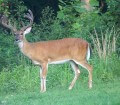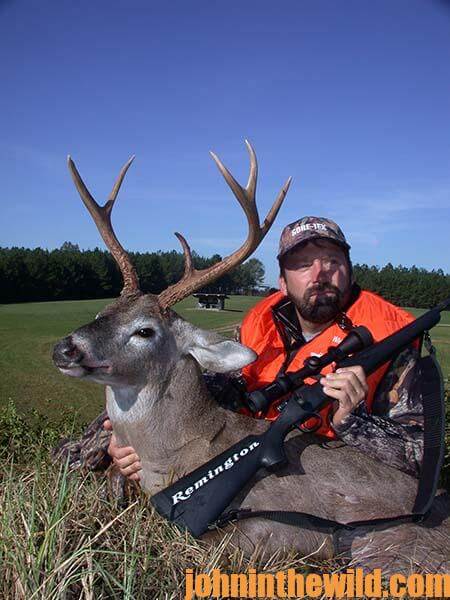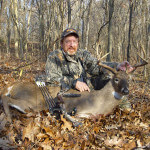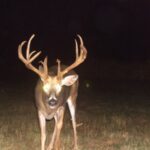John’s Note: During the post deer season, deer hunters can obtain a reasonable indication of the numbers and sizes of bucks that have eluded hunters and will be available during the upcoming season. 
Within a week after hunting season ends, the larger, trophy-size bucks begin to come-out of hiding and resume normal activities.
Often you’ll see these big bucks on the edges of agricultural fields, near food plots or at watering holes during daylight hours. Once you’ve spotted a trophy buck like this, start hunting that animal. Find the trail he uses to travel to the place where you’re seeing him. Follow that trail back into the woods and into heavy cover, because this trail will point the way to the hideout the big buck has utilized throughout the deer season. Set-up a stand, and make sure you see the buck going into that heavy cover. Later, in the middle of the summer, move into the buck’s hideout, cut shooting lanes, find a tree stand site, and make all the preparations needed to be able to take that buck when hunting pressure builds-up the following season.
Tell no one where your big buck hideout is. During the last couple of days of the next deer season, when the area you’re hunting has a favorable wind, go to the tree stand site that you’ve selected months ago and wait. Because deer are creatures of habit, if they’re undisturbed, they’ll often utilize the same sanctuary year after year to dodge hunting pressure. By locating that sanctuary after deer season, coming up with a hunt plan, setting up a stand site months ahead of the season and not going into that sanctuary until the very end of the season when the trophy buck should be using it, you’ll greatly increase your odds of bagging that deer.
Use Trail Camera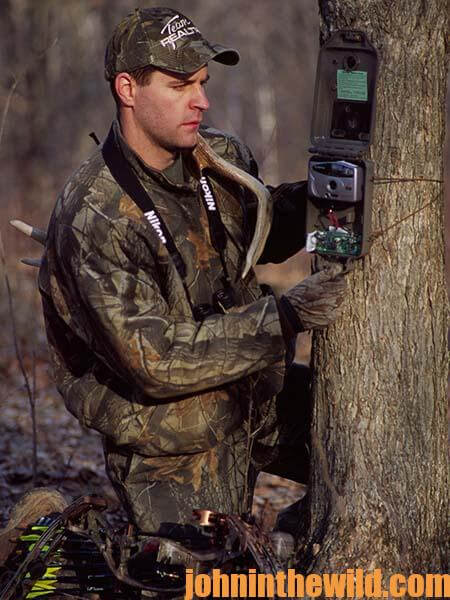 s:
s:
David Hale, one of the founders of Knight and Hale Game Calls, has used motion-sensor cameras for years, because he says, “I felt it was a good way to inventory the animals I had on my property, besides learning where and how deer moved. I’ve found that many hunters spend hundreds and maybe thousands of hours hunting trophy bucks that don’t exist on their properties. So, I’ve learned that by using motion-sensor cameras, I can determine if a piece of property has the size of buck that I want to hunt before I ever hunt that land. I use trail cameras to pattern the bucks to know where they’re bedding and feeding, the trails they’re using in-between, and the time of day they’re walking those trails. The critical key to being able to find and set-up a hunting pattern for a buck is getting the cameras into position to give you the information you need well ahead of the hunt.”
Hale prefers to have the cameras in place and working for about 2-months before he hunts. He says, “One of the things I’ve learned is that many times, deer will change their movement patterns before you hunt them.” This change makes the information gleaned from the cameras, 2 to 3 days before the hunt, the most-critical information for the success of the hunt.”
Hale prefers using digital cameras, since they produce many-more photos than a film camera will without having to change film and cost far less to operate than a film camera. With a digital camera, Hale says, “I can get 200 to 300 photos in several days without having to return to the camera site and leave human odor on the way to the camera and coming away from the camera. The fewer trips you have to make to your camera, the less odor you leave in the woods, and the less you disturb the deer, which results in the information that you get from the cameras being much more reliable.”
Study Deer Behavior:
A very-important factor to be consistently successful in taking deer is understanding deer behavior, and here’s another place that using trail cameras comes in handy. However, very-few hunters take the time to study the animals they plan to harvest. Yet, this one factor will teach you more about deer and deer hunting than any other hunting technique. During hunting season, deer usually change their normal movement patterns in response to hunting pressure. Oftentimes, if hunting season coincides with the rut, the buck’s behavior is altered even more. So, the hunter gets a distorted picture of what the animal’s behavior is really like, because the buck is constantly in danger. However, after the season when the hunting pressure is removed, the hunter can go to a green field with a quality pair of binoculars or a spotting scope and study the deer’s behavior.
If deer season ends while the rut’s in progress, you may be able to see a sparring match between two bucks. By carefully observing what deer do when they spar, the hunter can learn how to use rattling antlers and grunt calls. Watch how the deer use their feet. Take note of the way the antlers sound when they clash together. Listen to determine if the animals grunt when they push each other back and forth. Once you’ve made these observations, you more effectively can utilize hunting aids to call-in bucks.
Also study the does. Observe what the buck does when the doe is alerted to danger. Try to determine how the does alert the buck to danger. Note the direction from which the does approach and leave a field. Study the behavior of the younger bucks, and take good notes.
Much of the information about deer and their behavior being disseminated comes from firsthand observation from outdoorsmen who’ve spent hours studying deer. The very-best deer hunters are the men and women who possess the most knowledge about the animals they hunt. Therefore, if you want to improve your skills as a deer hunter, there’s no substitute for studying the animals and learning habits.
To get “How to Hunt Deer Like a Pro,” click here
About the Author
John Phillips, winner of the 2012 Homer Circle Fishing Award for outstanding fishing writer by the American Sportfishing Association (AMA) and the Professional Outdoor Media Association (POMA), the 2008 Crossbow Communicator of the year and the 2007 Legendary Communicator chosen for induction into the National Fresh Water Hall of Fame, is a freelance writer (over 6,000 magazine articles for about 100 magazines and several thousand newspaper columns published), magazine editor, photographer for print media as well as industry catalogues (over 25,000 photos published), lecturer, outdoor consultant, marketing consultant, book author and daily internet content provider with an overview of the outdoors. Click here for more information and a list of all the books available from John E. Phillips.

